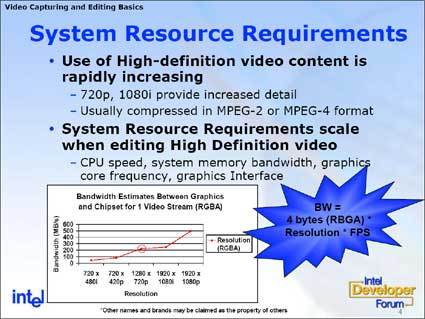Future Promise for Graphics: PCI Express
PCI Express, Continued
One thing became painfully clear at the recently held Intel Developer Forum, at which PCI Express was probably among the hottest topics on the agenda: PCI Express is going to be hard to sell to the consumers. Consequently, the biggest question was "How do I convince the consumer he/she needs this technology?" One could have almost gotten the impression that the experts assembled there were desperately searching for any argument in favor of PCI Express - at least for the graphics sector. Finally, the marketing experts singled out their new favorite killer application: real-time HDTV video editing. According to their (un)conventional wisdom, this is the application that will make consumers ditch their current motherboard and graphics card and trade them in for PCI Express components...
Not likely!
Why video editing, anyway? Simple, it can take advantage of the upstream bandwidth that PCI Express brings to the table. You can see the cogs turning in the marketing executives' heads as the argument falls into place: "If we can't find an application that can take advantage of the high data transfer rates towards the graphics cards, then let's find one that that benefits from all that upstream bandwidth!" Sheer genius, really. After all, upstream bandwidth can be quite limited on the AGP bus. Also, when it is used, it reduces the available downstream bandwidth (more on this later). This is where things get interesting.
Graphics chipmaker NVIDIA announced the first PCI Express capable graphics cards at IDF. Instead of developing a completely new line of chips, NVIDIA will simply use their existing family of AGP graphics chips on their first wave of PCI Express cards. These cards, called GeForce PCX, will interface with the PCI Express bus through a bridge chip, called the HSI (High Speed Interconnect). At first glimpse, it would seem that as a result, these chips wouldn't be able to take advantage of the new PCI Express features, since the AGP connection between the bridge and chip would continue to be the "bottleneck".
IDF presentation on video editing. This shows the bandwidth of UNCOMPRESSED HD video streams. It will be hard to find a hard disk that writes data at that speed...
ATi has chosen the other path, speaking out in favor of native PCI Express support from the beginning. A native implementation makes a lot of sense in the long term view. Now, however, NVIDIA's HSI chips seem like a clever strategy, even though ATi is doing its best to undermine it with the argument of upstream bandwidth HDTV video editing.
Get Tom's Hardware's best news and in-depth reviews, straight to your inbox.
Current page: PCI Express, Continued
Prev Page PCI Express, Continued Next Page Bridge It - NVIDIA's HSI Bridge